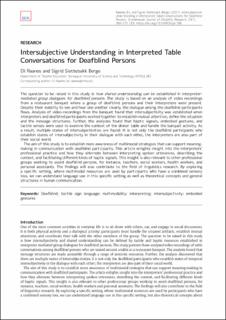| dc.description.abstract | The question to be raised in this study is how shared understanding can be established in interpreter-mediated group dialogues for deafblind persons. The study is based on an analysis of video recordings from a restaurant banquet where a group of deafblind persons and their interpreters were present. Despite their inability to see and hear one another clearly, the dialogue among the deafblind participants flows. Analysis of video-recordings from the banquet found that intersubjectivity was established when interpreters and deafblind participants worked together to establish mutual attention, define the situation and the message structures. Further, the analyzes found that haptic signals, embodied gestures, and tactile senses were used to examine the context of the dinner table and handle the banquet activity. As a result, multiple states of intersubjectivities are found: It is not only the deafblind participants who establish states of intersubjectivity in their dialogue with each other, the interpreters are also part of their social world.
The aim of this study is to establish more awareness of multimodal strategies that can support meaning-making in communication with deafblind participants. This article enlights insight into the interpreters’ professional practice and how they alternate between interpreting spoken utterances, describing the context, and facilitating different kinds of haptic signals. This insight is also relevant to other professional groups working to assist deafblind persons, for instance, teachers, social workers, health workers, and personal assistants. The findings will also contribute to the field of linguistics research. By exploring a specific setting, where multimodal resources are used by participants who have a combined sensory loss, we can understand language use in this specific setting as well as theoretical concepts and general structures in human communication. | en_US |

